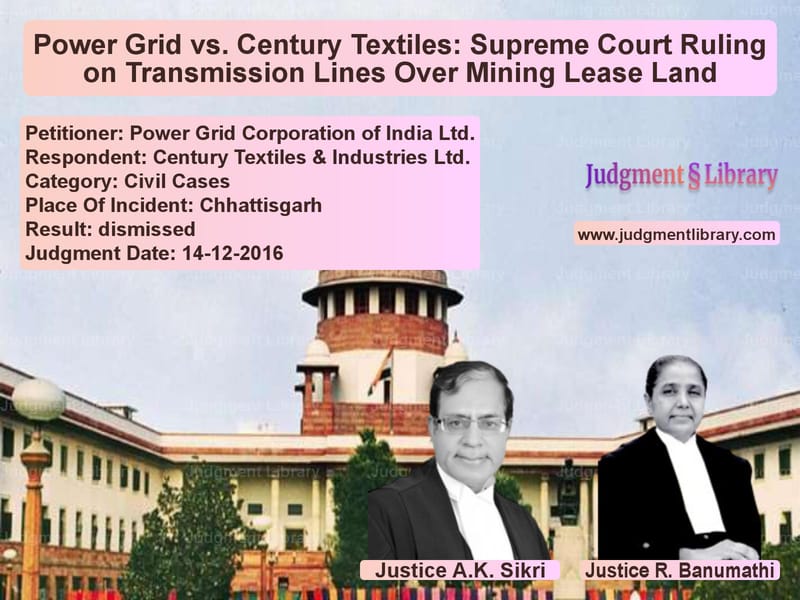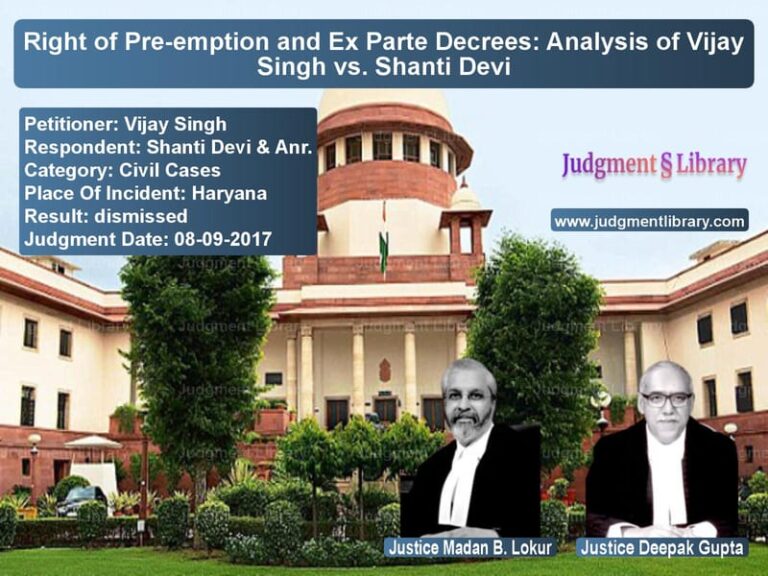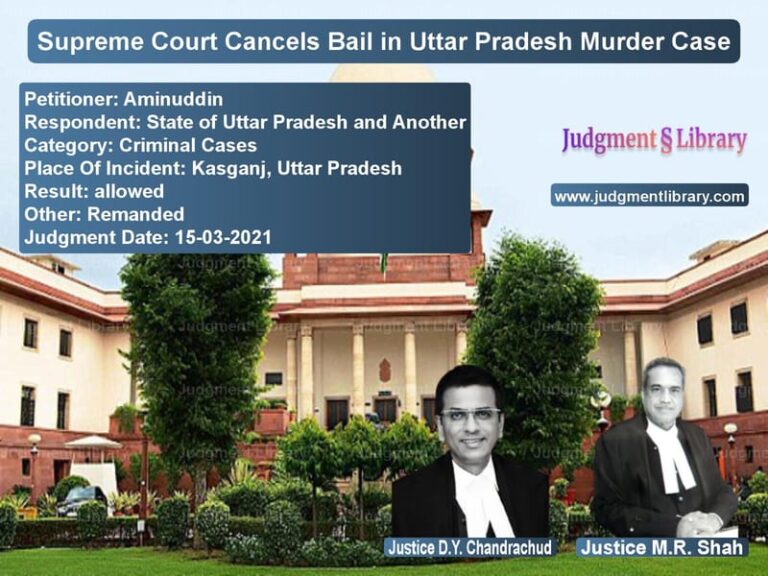Power Grid vs. Century Textiles: Supreme Court Ruling on Transmission Lines Over Mining Lease Land
Infrastructure development and industrial operations often come into conflict when large-scale projects overlap in land usage. The case of Power Grid Corporation of India Ltd. vs. Century Textiles & Industries Ltd. brought this issue to the forefront, dealing with the legality of erecting high-voltage power transmission lines over a mining lease area. The Supreme Court judgment, delivered on December 14, 2016, addressed key legal questions about land use rights, compensation, and the balance between public interest projects and private industrial operations.
Background of the Case
Century Textiles & Industries Ltd. operates a cement manufacturing plant in Baikunth, Chhattisgarh, and was granted a 30-year mining lease over 74.843 hectares to extract limestone. The lease was executed with the State Government in 2002, and modifications to the mining plan were approved in 2005. Meanwhile, Power Grid Corporation of India Ltd., a government-owned entity responsible for electricity transmission, was constructing a 400 KV Sipat-Raipur transmission line. This line passed through the mining lease area of Century Textiles, raising concerns about operational disruptions.
Power Grid began construction of transmission towers in 1996, and the transmission line was commissioned in 1999. However, Century Textiles objected when the new transmission project involved erecting additional towers within its mining area, arguing that it would prevent essential blasting operations required for limestone extraction. When negotiations failed, Century Textiles filed a writ petition in the Chhattisgarh High Court, seeking an injunction against the project.
Petitioner’s (Century Textiles) Arguments
- The mining lease area contained 10 million tonnes of limestone, critical for cement production.
- The erection of power transmission towers would prohibit blasting within a 500-meter radius, rendering a substantial portion of the mining lease unusable.
- The company contended that the Power Grid had not sought prior consent before constructing the towers, violating Sections 68 and 69 of the Electricity Act, 2003.
- The project would result in significant financial losses, estimated at ₹690 crores to Century Textiles and ₹120 crores in lost royalty revenue for the State Government.
- The company argued that relocating the towers would cost only ₹4.5 crores, making it a feasible alternative.
Respondent’s (Power Grid) Arguments
- The transmission project was a critical infrastructure initiative, part of the national power grid ensuring electricity transmission to underserved areas.
- By the time Century Textiles objected, 85% of the project was completed, with 390 out of 400 towers already erected.
- Power Grid had obtained all necessary government approvals, including clearance under Section 68 of the Electricity Act.
- Under Section 164 of the Electricity Act, 2003, Power Grid had the same powers as a Telegraph Authority, allowing it to construct transmission lines without seeking prior consent.
- The transmission lines followed a fixed alignment, and any change would introduce technical difficulties and additional costs.
- Century Textiles had already been operating its mine near an existing 400 KV transmission line since 1999 without issues.
Supreme Court’s Judgment
The Supreme Court, with a bench comprising Justice A.K. Sikri and Justice R. Banumathi, upheld Power Grid’s position and ruled against Century Textiles. The key findings were:
- Under the Electricity Act and the Indian Telegraph Act, Power Grid had the legal authority to install transmission lines without requiring landowner consent.
- Sections 68 and 69 of the Electricity Act, 2003, and Rules 3 and 10 of the Works of Licensees Rules, 2006, were not violated since the government had granted all necessary approvals.
- By the time the dispute arose, 408 out of 410 towers had been erected, making realignment impractical.
- Relocating the towers would disrupt national energy infrastructure and was not a viable option given the stage of completion.
- The court noted that alternative mining methods that did not involve blasting could be used in the affected area.
- Accordingly, the court dismissed Century Textiles’ appeal and permitted Power Grid to proceed with its transmission project.
Compensation Dispute and Its Resolution
The Chhattisgarh High Court had ruled that the District Collector should assess compensation for Century Textiles and the State Government for losses incurred. However, the Supreme Court overturned this decision, stating that:
- Compensation claims must be settled by the District Judge under Section 16 of the Indian Telegraph Act, 1885.
- Since Century Textiles had not formally sought compensation in its original petition, the High Court had no authority to direct the District Collector to assess damages.
- Century Textiles was advised to pursue compensation claims through civil litigation or under the guidelines issued by the Central Government on October 15, 2015.
Key Legal Takeaways
- Transmission companies operating under the Electricity Act and the Indian Telegraph Act have the legal right to install power lines over private land.
- Industrial operations must account for existing and planned infrastructure when securing land for projects.
- Consent from landowners is not required when the government confers special authority under Section 164 of the Electricity Act.
- Compensation for landowners affected by transmission projects should be pursued through civil courts rather than administrative bodies.
Conclusion
The Supreme Court’s judgment in Power Grid vs. Century Textiles underscores the importance of balancing infrastructure development with industrial interests. While mining operations play a crucial role in economic growth, electricity transmission is a fundamental necessity for national progress. This ruling clarifies the scope of government powers in land acquisition for public utilities and establishes legal precedents for compensation claims in similar disputes.
Don’t miss out on the full details! Download the complete judgment in PDF format below and gain valuable insights instantly!
Download Judgment: Power Grid Corporati vs Century Textiles & I Supreme Court of India Judgment Dated 14-12-2016.pdf
Direct Downlaod Judgment: Direct downlaod this Judgment
See all petitions in Property Disputes
See all petitions in Judgment by A.K. Sikri
See all petitions in Judgment by R. Banumathi
See all petitions in dismissed
See all petitions in supreme court of India judgments December 2016
See all petitions in 2016 judgments
See all posts in Civil Cases Category
See all allowed petitions in Civil Cases Category
See all Dismissed petitions in Civil Cases Category
See all partially allowed petitions in Civil Cases Category







